Volleyball drills for technique passing / defense / reception
- 4 players on each side of the net,
- 1 at each antenna,
- 2 together in the middle on the 5 meter
- 2 teams, sometimes 3 teams
- Throw the ball underhand, fellow player plays it back underhand.
- Assignment, ball must be returned with a nice curve.
- After 10 throws, change, and continue.
- Throw in the ball underhand, teammate plays it back underhand, again in a nice curve,
- Ball is not caught but returned overhead.
- Ball is thrown underhand, fellow player shuffles backwards, and plays back underhand with a nice arc.
- Trainer smashes, throws balls to 3 players on 1 playfield.
- Players 1, 2 and 3.
- Per turn 3 balls.
- These 3 players have to process the smash into a pass to the midfield, in a nice curve.
- Midfielder catches the ball, and puts it back in the ball bin.
- Watch out:
- Player 3 leaves the field, the other 2 move up and are supplemented by new players. Rotation.
- Both sides set up a team, normal game line-up.
- Trainer throws ball into the backfield, team defends and builds up attack, opponent idem, ball is introduced by trainer where mistake is made.
- Quick switching, lasting rallies and no delays as a result of service.
- Regularly turn at the indication of the coach.
- All players take a ball (except 2 players).
- The 2 players without the ball both stand in the middle on one side of the net.
- The other players all line up at position 4,
- the first player throws his ball/or touches in a good intention towards the player who gives the pass.
- The first player throws his ball/or key in a good intention to the player who gives the pass.
- The ball is caught and this player continues to the other side of the net.
- This player does the same while the second player can already set up at the first pass.
- When all players have been through both passeurs they will be exchanged.
- Until everyone has passed. (If this works well after a few practice sessions, you can then build up to a possible attack as well!)
playmakers and libero:
- libero goes to position 5.
- 1 distributor stands on position 2/3.
- 1 player stands at position 4 (next to the basket) and plays the ball to the libero.
- ==> to position 2/3
- ==> set-up in the basket. after 10 balls distributors change.
- set-up forward both 2x
- set-up backwards both 2x
- libero set-up forearms 20balls own choice forwards
- libero set-up forearms20 ballsbackwards. (other player will throw the ball)
other half
other players:
- Make threes.
- 1ballper trio. Line up on the backline.
- Number 1 has the ball. Play the ball overhand backwards to number 2 and so on.
- Number 1 stays behind until you reach the net.
- 3 times get the net without dropping the ball.
2. pass the ball underarm to each other in a triangle.
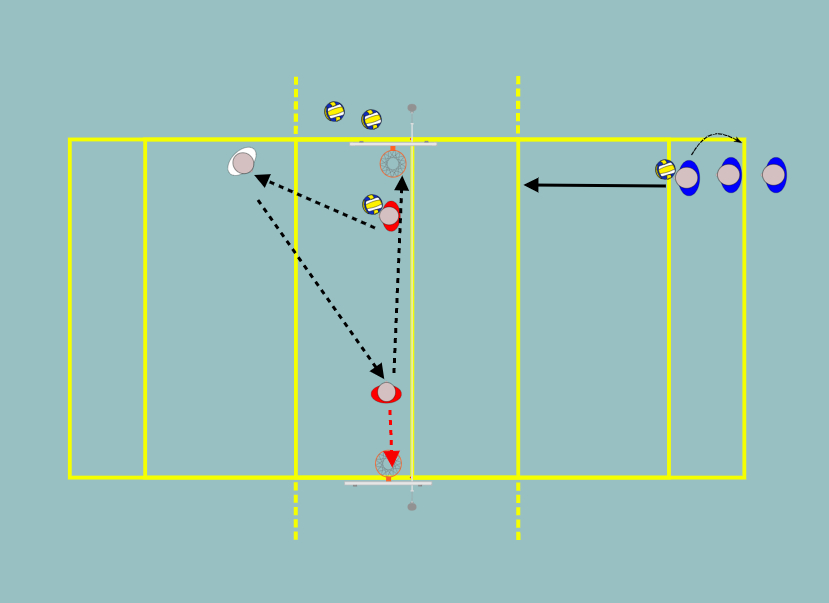
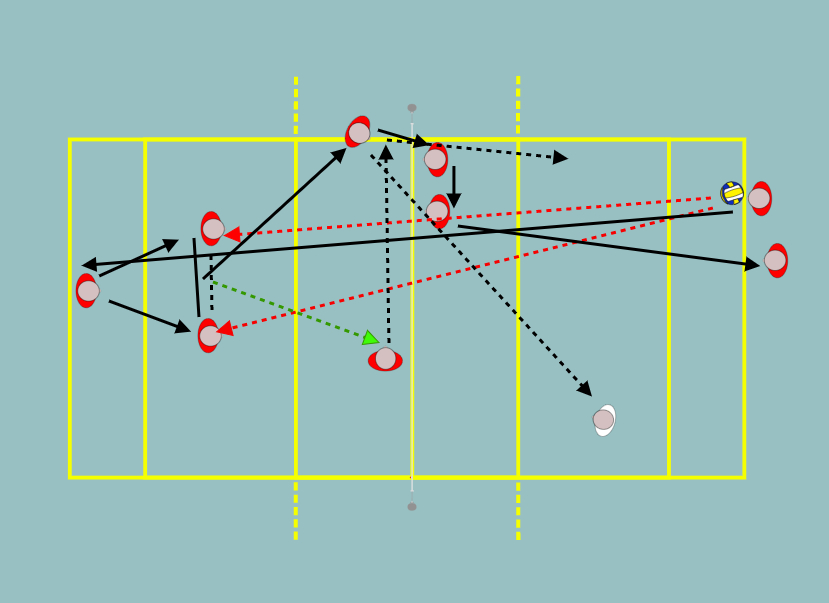
positions:
- 2 passers on position 5/6 and 1/6, 1 reserve passer behind the field.
- 1 playmaker on position 2/3.
- 1 attacker on position 4.
- Other half:
- 2 blockers.
- Libero at position 5.
- 2 servers on the backline.
Turn over:
- player serving the ball becomes reserve passer
- ==> becomes passer
- ==> passer who passes the ball
- ==> attacker
- ==> out blocker
- ==> outside blocker
- ==> middle blocker
- ==> server.
GOAL: Do not be afraid of the blocker and just hit the ball. You can hit the ball straight on or diagonally. The blocker closes the straight on but if you see a hole you can hit it there too.
CHANGE:
- after 2 minutes a change of playmaker
- after 2 minutes change of play-distributor ==> libero starts to distribute the game. one center will defend on position 5
- after 2 minutes change of play-distributor 1 again. and attack backwards. After two minutes playmaker 1 switches to blocking and attacks backwards.
- After 2 minutes distributor 2 starts distributing the game.
- after 2 minutes libero starts to distribute --> the center starts to defend on position 5.
- Storage -> reception -> pass to 4 (diagonal) alternating with 2 (street) -> defence with 2
- Variant: attack on 4 (street) alternating with 2 (diagonal) 7
- Receptionists always turn around
- After 2 good actions turn around
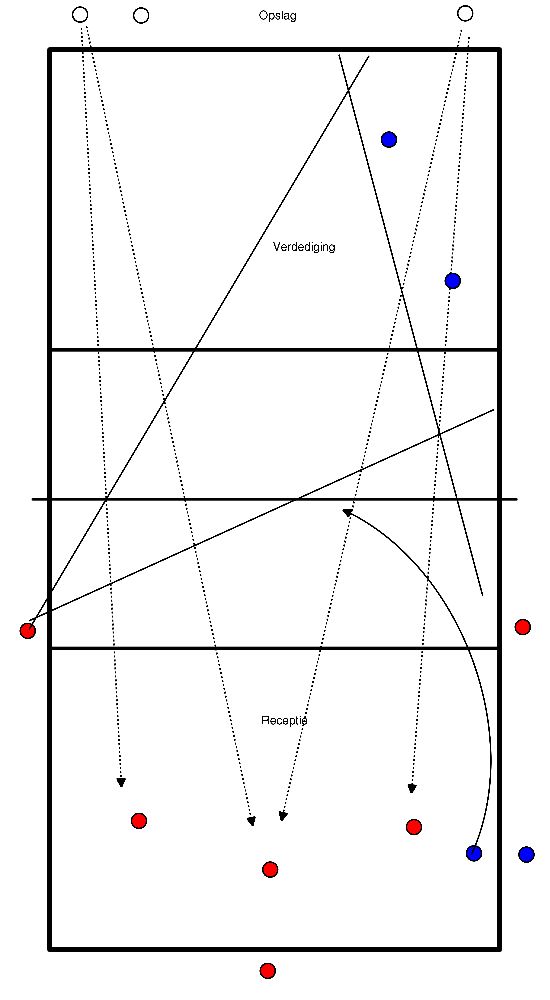
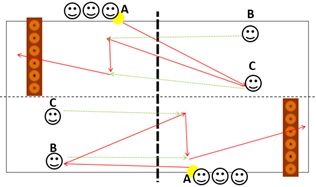
- Player A throws ball over the net.
- Player B or C passes the ball over the net.
- The other player quickly runs under the net and sets up the ball for the same player who passed.
- This player tries to get a pawn off the bench with overhand play or a hitting move.
Which pair or team has knocked the most pawns off the bench after X number of minutes?
everyone a ball
- play the ball underarm independently. (2 minutes)
- Play from your legs, no arm waving.
- keep your arms stretched
- Make sure the ball falls on your wrists.
- Push your hands downwards.
2. pass the ball underarm in pairs (8 minutes)
- play under the net (force your knees to go up)
- 3 meter from each other (1 side of the net)
- 6 meter from each other (1 side of the net)
- play the ball over the net to each other underarms
Warming up / all-round training
Each player will pass, attack, distribute, block, defend, rally, with turnovers.
#2 means
- Trainer stands with cart with balls at the pole at #2 (position 2)
- Players stand outside the field at the side of #1 and a playmaker at # 2/3
- First round starts with Trainer throwing the ball to #5, player 1 runs from the sideline to the ball and plays it to the distributor.
- Start with "blue players" (see drawing), then extend with "red players
Further course of play:
- Tr throws ball for S1 to #5
- S1 runs in and plays to Sv (#2/3)
- Sv gives setup to the outside (#4)
- S1 attacks.
- Turn over: S1 becomes Sv, Sv gets the ball and joins the line at #1.
Expansion 1
- Sv turns to the other side of the net and becomes a blocker.
Now the same steps as above, but with the block opposite the attacker. - Turn over: S1 (has just attacked) becomes Sv at #2/3, Sv
passes under the net and becomes B1 at #2B1
who, after blocking, goes to get the ball and joins the row.
Extend 2
- After blocking at #2, player goes to defend at #5. Attacker is obliged to pass to #5.
- When the ball is defended a rally may be played (2 vs. 2)
- After end of rally or no defence or fault in attack, turn over
Extend 3 and more
- One can extend with a 2nd blocker, 2nd and 3rd defender (on resp. #1 and #6)
- More players can be added to field I (so players from the sideline move in when a rally arises)
- The passing game becomes S1 (passing and attacking) -> Sv -> B1 (#3) -> B2 (#2) -> V1 (#1) -> V2 (#6) -> V3 (#5) possibly A2 (#4) and then connect again.
- You can expand to 6 against 6, so start with blue, then B1, then B2, then V1, then V2 (when continuing the game, first V2 and then V1), then V3 (continuing the game with V2, V3, V1) and then possibly A1. In the meantime, players in field I must be added.
- If there are several players in Area I, you can choose to throw in a ball on S1 at #5 instead of throwing in a ball through Tr.
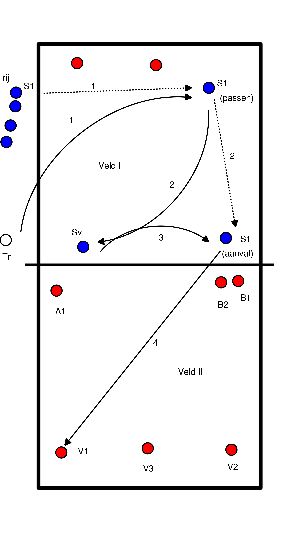
- In today's top basketball we can see that the two-handed pass from above the head is frequently used.
- It is therefore important that we stimulate the players to use this pass in certain situations.







